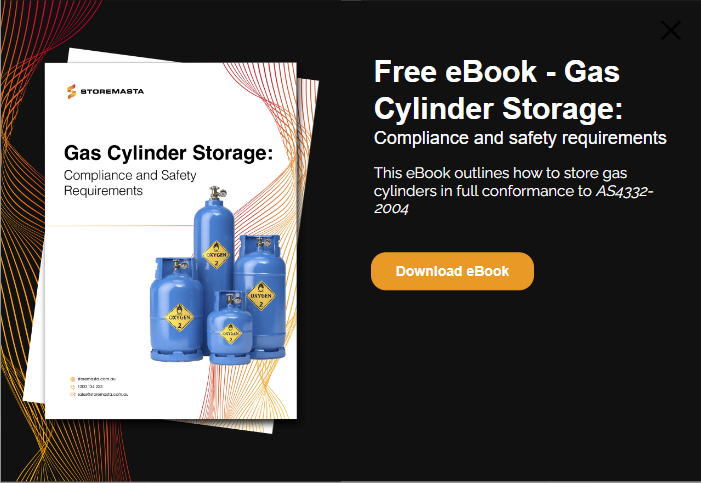Compressed gases must be stored correctly; separated from other Dangerous Goods and segregated within their Hazard Classification. This blog identifies and describes the three classes of compressed gases that are incompatible and the requirements for their correct segregation.
Classifying gases and other dangerous goods
In Australia all dangerous goods are identified and classified by the Australian Dangerous Goods Code (ADG Code). Each substance is assigned to one of nine different hazard classes based on the most predominant hazard they present.
Even though the chemical properties of individual compressed gases usually creates multiple hazards, (eg, ammonia gas is flammable, toxic, and corrosive), they will still only be assigned to one hazard class. So the gases should always be segregated by the hazard class assigned by the ADG Code.
REMEMBER: Always check the individual Safety Data Sheet (SDS) issued by the supplier for the assigned hazard class of each gas as well as any additional instruction for segregation and storage.
Class 2.1 Flammable Gases
Flammable gases are generally used by workplaces for welding and cutting, powering forklifts and other vehicles, heating, and cooking. Flammable gases like LPG, acetylene, hydrogen, propane, propylene and methane are also referred to as fuel gases and can ignite easily or explode.
Class 2.1 Flammable Gases must be segregated by at least 3 metres from Class 2.2 (5.1) Non-flammable, Oxidising Gases and Class 2.3 Toxic Gases.
Class 2.2 (5.1) Non-flammable, oxidising gases
Oxidising gases are not flammable themselves, but can spontaneously assist the ignition of a fire or explosion. Oxidisers do this by increasing the oxygen content of the air (also called oxygen enrichment). Combustible materials in an oxygen enriched environment ignite more easily, burn much hotter (and with more intensity), and are much harder to extinguish.
Class 2.2 (5.1) Non-flammable, Oxidising Gases must be segregated by at least 3 metres from Class 2.1 Flammable Gases and Class 2.3 Toxic Gases.
Class 2.3 Toxic Gases
The chemical properties of toxic and corrosive gases pose a serious health risk to people and often the environment too. Any exposure to toxic gases is harmful — and depending on the toxicity of the gas and degree of exposure — can lead to an acute injuries (blindness, rash) or chronic conditions (asthma, cancer).
When toxic gases are inhaled or ingested they begin moving throughout the bloodstream. They can quickly penetrate internal organs like the lungs, liver, kidneys, reproductive and nervous systems. Even minimal exposure to toxic gases can be fatal.
Class 2.3 - Toxic Gases must be segregated by at least 3 metres from Class 2.2 (5.1) Non-flammable, Oxidising Gases and Class 2.1 Flammable Gases.
Risks and Hazards of Incompatible Gases
Worn threading, damaged valves, loose connections, dropped or impacted cylinders: all gases stored under pressure are susceptible to leaks. Leaked gases can then quickly fill rooms and confined spaces, or travel long distances to ignition sources. Gas leaks is one of the main reasons why incompatible gases and other Dangerous Goods must be isolated and then segregated.
Class 2.1 flammable gases in contact with Class 2.2 oxidisers can instantly ignite or explode, creating a catastrophic fire or even another dangerous event involving Class 2.3 toxic gases. Because any gases stored under pressure will begin to expand when heated, a gas cylinder containing toxic gas can explode when exposed to the heat of a fire. Segregating gas cylinders according to their hazard class reduces the risk of fires, explosions and dangerous chemical reactions.
How to segregate incompatible gases
There are two aspects to segregating gases and other dangerous goods: the cylinder stores must be isolated, then the cylinders individually segregated into hazard classes.
1. Isolating cylinder stores
Cylinder stores must be isolated from:
- Building openings (windows, doors, vents, ducting)
- Site boundaries
- Places where other dangerous goods are store, filled or decanted
- Combustibles
- Refuse
- Vegetation
- Ignition sources
- Industrial heat
- Protected places (residences, places of worship, schools etc)
2. Segregating gas cylinders
Incompatible gases must be then segregated within the cylinder store. This is done by sorting gas cylinders into their three hazard classes (flammable, oxidising, toxic) and locating them at least 3 metres apart.
If the 3 metre distance is not possible, the segregation can be legally achieved by introducing a screen wall at least 1 metre higher than the tallest cylinder. This screen wall may only be constructed from non-combustible materials that are impervious to the gases stored on either side.
Segregation rules may be affected by the types of gases used and the amount of cylinders being stored. Always consult Section 4.2 of AS 4332 - The storage and handling of gases in cylinders when erecting cylinder stores.
IMPORTANT: Empty cylinders must be labeled empty, then separated from full cylinders. Empty cylinders also require segregation into their hazard classes.
Next Steps
If you need more information about controlling the risks and hazards associated with gas cylinders, why not download our free eBook Gas cylinder storage: Compliance and storage requirements. Our comprehensive eBook is an excellent resource for WHS Managers needing a clear and easy-to-follow risk management methodology. Download it now by clicking on the image below:
Joining the team as a Dangerous Goods Storage Consultant, Melissa Hampton became Storemasta's Marketing Manager in late 2021. With extensive knowledge and experience in chemical compliance, Melissa is responsible for leading the Marketing team and helping shape their marketing strategy. In her spare time, you can find Melissa hiking, swimming and enjoying the great outdoors in beautiful north-west Tasmania.
